On few travels have I not witnessed the consequences of mass tourism, where not even uninhabited or protected areas were spared of overcrowding, noise, or garbage pollution. My impression was that the most pristine and beautiful places on the planet only survived because distance or access restrictions kept them away from human invasion.
Tossed in the middle of the Pacific and zealously protected by the authorities, the Galapagos Islands were among the few remaining wildlife sanctuaries.
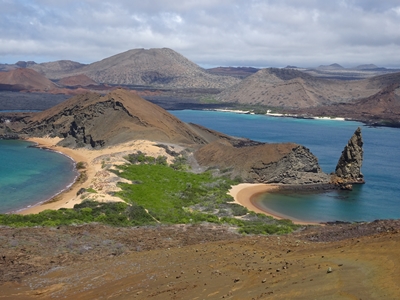
Of the twenty-one volcanic islands that made up Columbus’ archipelago, only three – Isabela, San Cristobal, and Santa Cruz – were inhabited. The latter was also the main entry point for the travelers to the archipelago.
The passengers were not allowed to leave the aircraft until one of the flight attendants opened all the hand luggage compartments and disinfected them with a special spray. From the very beginning, it was made clear to us that the ecosystem of the islands was extremely fragile. The rules seemed to imply that even the most insignificant intruder could trigger a fatal chain reaction.
The influx of tourists was strictly controlled. In addition to heavy limitations on the number of flights and a total ban on cruise ships, no visitor was allowed to stay in the Galapagos for more than 60 days a year, and each had to pay an entry fee of $100. I had to fill in a very detailed entry form in order to get an entry card.
My plan for the next day was to reach South Plaza, a small, wild island east of Santa Cruz. Of the pair of islands called Plazas, only the southern one could be visited; the northern one was being used for research purposes.
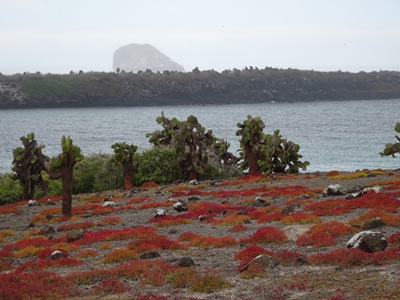
I was going there in a solid, well-maintained, and spacious boat. It was an entirely different league compared to any boat I had ever taken on such trips, especially in Asia, but that was the standard in the area. Of course, the price was commensurate. There were no cheap trips with cheap boats. “Few but good” seemed to be the basic principle.
Access to wildlife was severely restricted. Each day, the uninhabited islands could only be visited by a limited number of people in small groups brought by authorized operators. The latter were assigned a specific time interval, generally of about two or three hours, to disembark their customers and show them around. Then, they had to raise the anchor and make way for the following group.
On my boat, we were not more than ten people. Among us was an American couple from San Francisco who were traveling with their own yacht. They had come from the North American coast all the way to Ecuador. However, in the Galapagos, they said, they were not allowed anywhere on their own. In order to see the wildlife, they had no choice but to sign up to the authorized trips. They were in possession of a drone that they would sometimes use to take pictures or shoot movies, but the use of drones was also prohibited outside inhabited areas.
On the island, we were only allowed to walk on a dedicated path, under the supervision of our local companions, without disturbing the animals in any way. The Ecuadorian guides imposed an iron discipline. I was pleasantly impressed by their efforts, as well as by their training. They were all specialized in natural sciences, experts in the fauna and flora of the islands.
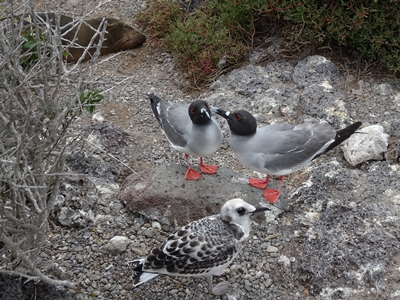
Right where we set foot on the shore, I spotted a sea lion pup lazing on the rocks. The little one was drying his beige-golden fur in the sun, watching us out of the corner of his black eyes. He showed no indication that he cared about our presence when we passed by. The obligation to keep at least two meters away from any wild animal seemed to have a different meaning than I had imagined. As I was about to find out, in the Galapagos, no animal was scared of humans, not even the birds. The two-meter limit was primarily for their protection, not for ours.

The path literally carried me through bird nests built directly on the ground. Some of the birds were feeding their chicks, and others performed dances to attract a pair or to intimidate rivals. At one point, I saw a seagull that had legs as blue as the sky. The color was unbelievable, as if taken out of a tube of acrylics for painters.
“The more intense the blue of the legs, the more attractive they are to the opposite sex,” I was told.
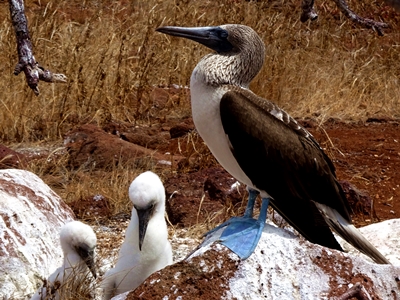
The next day, I was scheduled to arrive at North Seymour, a place recommended especially to those who were passionate about bird watching. I thought I was going to see a lot of birds, but what I found there exceeded all my expectations.
It was a bird island, literally. There was no piece of land that was not taken over by them. There were, first of all, many blue-footed boobies, which nested directly on the ground. At that time, their chicks were quite big, but not big enough to fly. They could be seen in almost every nest – a white fluffy creature like a large ball of cotton candy, moving awkwardly on its feet, as if it were ashamed of them because they hadn’t yet acquired their famous azure color, the pride of their species. One of the parents was always watching nearby, and the other was bringing food from the sea.
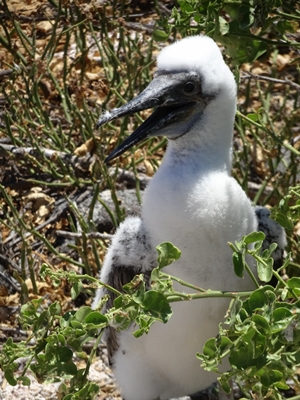
Frigate birds were the most vocal presence, being in full mating season. Those large creatures with black feathers, split tails, and long beaks, had a unique and astounding feature: an enormous red gular sac. To charm the females, the males swelled their feathers, spread and fluttered their wings seven feet long, and inflated their throat pouch while keeping their heads and beaks up. Given this was their main chance to attract a partner, they spared no effort. I saw birds with chests so large and swollen that they looked like balloons ready to burst at any moment, or rise in the air together with the bird reduced to a mere annex. As if the visual show wasn’t enough, they made guttural drumming sounds as if an entire army was preparing for battle.
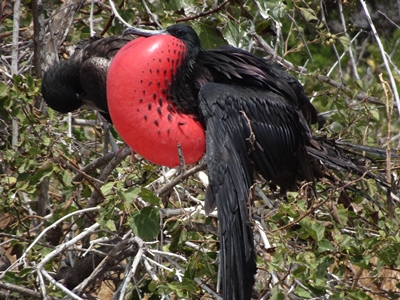
In addition to birds, there were massive iguanas on the island, with golden-yellow or dark scales, nesting and hiding under the bushes. They were like little fairy tale dragons, some more than three feet long.

Beyond the sound of the birds and the roar of the ocean, a solemn peace reigned on that rocky piece of land. It was like a sanctuary in which the main object of worship was the multitude of bird nests. It induced an undefined feeling of reverence.